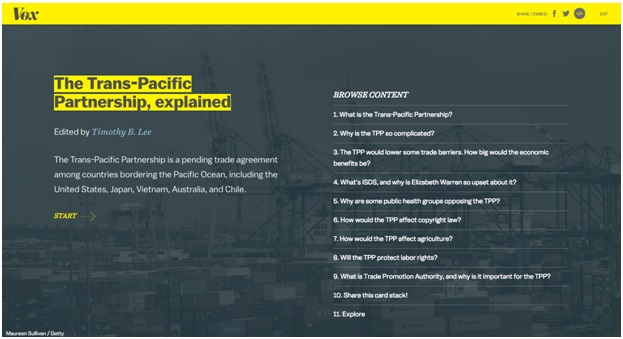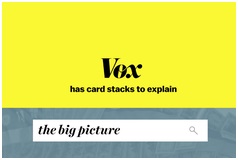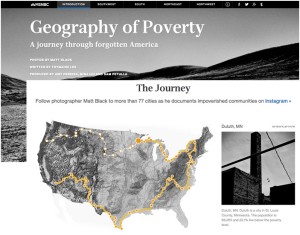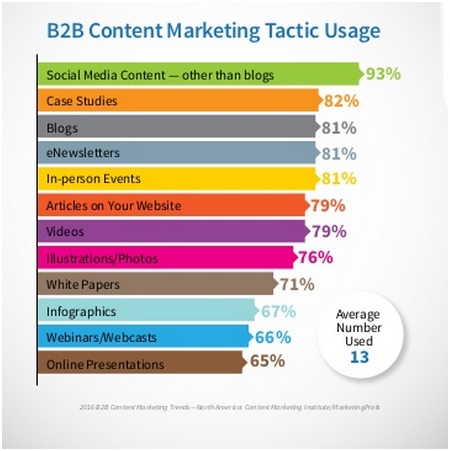Why Episodic Content Is a Must-Have
By Ted Karczewski
Whether we’re binge-watching House of Cards on Netflix because we just cannot go another day without knowing what happens to Frank and Claire Underwood, or we’re waiting patiently for the next episode of the Serial podcast, there’s a lot going on in our brains that cause us to react to episodic storytelling.
Think about it: As a narrative evolves over time, how does your mood change? How often do you jump back-and-forth between empathizing with a character to hating him or her in the next installment? What IS that crazy phenomenon, and why does it happen whenever we’re reading or watching a great story?
This week, we’re looking at Episodic Content. You can read the full round-up post of 6 content marketing trends to watch, and dive into the first two trends: content promotion and interactive content marketing.
Why Episodes Matter
Even in today’s age of binge watching, the best stories come in sections, effectively using suspense and anticipation to evoke a variety of emotions from an audience. This post will first look at how stories that leverage suspense and anticipation are instantly more memorable, and why empathy is the strongest emotion you can draw out of your customers. Then, we’ll apply this neuroscience and content theory to your strategy and ensure that you’re maximizing the resonance of every new asset you create.
First, let’s talk about why episodic content matters for your strategy. There are two core benefits to thinking in chapters in content strategy:
- When you organize your editorial and visual content creation process around themes and topics, you form a clearer vision of what you’ll be covering over a certain time frame and you become more organized as a team.
- Your audience grows accustomed to the style of information you’ll be providing them with, and that expectation sticks out in their memories. The more you produce around a series, the higher returning visitors you’ll see month-over-month, theoretically.
In the process of writing this post, I compared the average pageviews for all content published to the Content Standard between February 2014 and October 6, 2015 to the average pageviews of content published within an editorial series during that same time period. (For reference, some of our series include our Innovator Series, our Content Standard Case Study, our Instagram Strategy Series, and this 2016 Trends series here.) The results:
The average pageviews per article included in an editorial series is 124.3 percent higher than that of content published outside of a series.
The Content Standard isn’t the only publication that sees its episodic content performing at an above-average rate. The Atlantic‘s “If Our Bodies Could Talk” video series currently accounts for more than 17 percent of the site’s total video views. If you follow Doctor James Hamblin, the star of the series, on social media, you’ll also see a growing number of fans (some creepy, some not) asking him for advice, clues as to when the next clip will be released, and commenting on his looks (again, creepy).
Where are your fans? They’re waiting for you to develop a series worth subscribing to long-term. Here’s how:
Become the Hitchcock of Your Industry Through Suspense
Everyone’s favorite movies, TV shows, and sports events come with a certain amount of suspense. No one likes a blowout Football game (except for a few fans of the winning team), and when a plot is predictable, why bother watching?
Researchers from Istanbul Şehir University wanted to understand how suspense affects the way our brains work. The study’s core finding: The uncertainty of a close game is what brings people back from more.
Lead Researcher Sami Abuhamdeh tested the experiences of 72 undergraduate students as they played a few rounds of a video game. The study evaluated the participants’ levels of enjoyment, suspense, and perceived competence and performance when paired with a weak or tough opponent. In the end, 69 percent of participants actually chose to play the game they won by a slim margin again.
A separate study, this one from the Georgia Institute of Technology, monitored how viewers of films by Alfred Hitchcock—the master of suspense—behaved during high- and low-suspense scenes. Researchers found that during high-suspense moments, the brain narrows what people see and focuses attention on the story. When a story is less suspenseful, people become distracted and devote their attention to their surroundings. A good story includes both moments of high suspense and scenes of calmness.
“Many people have a feeling that we get lost in the story while watching a good movie and that the theater disappears around us,” said lead researcher Matt Bezdek. “Now we have brain evidence to support the idea that people are figuratively transported into the narrative.”
The majority of content marketers today don’t use suspense in the content they create. The blog you were proud of and published last week? Yeah, it wasn’t an”edge-of-your-seat” kind of read. We’re all guilty of it, and it’s not that we need to become Hitchcock, but we do need to understand how suspense and reserving some information at first, can make our content more memorable.
We see this sort of suspense being used in some advertising. For example, this recent commercial from Campbell’s Soup comes with a sweet twist at the end:
The suspense and eventual conclusion makes this clip emotional and relatable. However, this is all you get from Campbell’s on this topic. It’s a one-and-done effort, with minimal character development and no promise of something more to come. This might be a great story, but it’s a blip on our radar, that will quickly get swallowed up by the endless volume of content we’ll consume shortly after.What if Campbell’s put together a Web series on this family that included richer character development, points of conflict and resolution, and times of joy only found through family bonding? Instantly more memorable, shareable, and relatable.
Learn the Power of Anticipation in Storytelling
In storytelling, anticipation can be a good and bad thing. As a content marketer, it’s your job to understand when anticipation can work in your favor and when it can lead to stale marketing.
Researchers from the University of Wisconsin-Madison wanted to better understand how the simple act of anticipation affects our memory. The study found that the mere anticipation of a fearful situation can fire up two memory-forming regions in our brain. The main focus of this report was to better understand how to treat disorders like PTSD.
“Our study illustrates how the power of expectancy can extend to memory formation as well,” Jack Nitschke, a UW-Madison assistant professor of psychiatry and psychology wrote. “Just the expectation of seeing something bad can enhance the memory of it after it happens.”
However, fear isn’t the only emotion that leads us to anticipate something that has yet to happen. Neuroscientists at Georgetown University Medical Center found that anticipation is sometimes responsible for—and directly related to—action.
The scientists examined how people familiar with an album of music and people unfamiliar with it behave in-between songs. The results show the participants familiar with an entire album while listening have more brain activity than those unfamiliar with the work.
“This now explains how it is that, even before an anticipated song is actually heard, a person can start to tap fingers, dance, or sing to the music they imagine is coming next,” says Josef Rauschecker, PhD, director of the Program in Cognitive and Computational Sciences, at the University’s Medical Center.
Let’s look at how this science applies to storytelling and marketing.
First off, whether you’re publishing an editorial series or releasing video content periodically, your audience learns to anticipate the next in the series. While you likely don’t want to produce a ton of content that evokes fear from your audience, I’d guess that the logic in the study from UW-Madison also applies to other intense feelings like joy and sorrow. If you continuously create emotionally charged articles, videos, podcasts, and more, your audience’s memory-forming regions will fire up and they’ll be drawn closer to your work.
The second study poses a cooler opportunity—what happens when your audience comes to expect something from you? While you might not want to suddenly stop publishing in a series with no warning, you should play with anticipation to keep people on their toes. For example, if the main characters in your writing and visual media often find resolve by the end of the story, try leaving the audience with an open-ended conclusion once, or have that person fail another time. Anticipation can work both ways—keep your audience coming back because they know what to expect, but it can also be used to disrupt monotony and keep your audience guessing.
A good story allows you to anticipate what comes next, but it doesn’t reward all of your wishes in the end.
I recently spoke with Academy Award-winning screenwriter and director Dustin Lance Black about his “Crossroads” series for Coca-Cola. (Yes, I did just name drop in this post, and I’m not sorry about it.) One of my favorite aspects of Coke’s series is that it toyed with anticipation and suspense. In each video, Lance Black led the audience down a familiar path, in which teenagers were faced with making a tough decision. Society would have us anticipate the teen’s action (bully or make the cheap joke), but the plot would take a different direction, and immediately make our hearts flutter and our minds race. Sometimes showing your audience the opposite of what they expect works twice as hard to deliver results for your marketing.
Content Variety Requires Focus on Cadence and Delivery
We’re content marketers, not movie producers, so we have to understand how to adapt our content for multiple screens, devices, and delivery points. We don’t have the luxury of our audience consuming an entire series at one time, and we sometimes have to repackage our narratives for use elsewhere on the Web.
In the Content Marketing Institute’s 2016 B2B Benchmarks research, only 28 percent of respondents indicated that they have a documented editorial mission. It’s one thing to have a content strategy, but without a governing document to guide the style and voice of what you create, a series can quickly become inconsistent and disorganized.
With 81 percent of B2B marketers using blogs and 79 percent using videos, there are a lot of one-off posts being created and not enough synergy between content types and platforms.
We know that people like to get information in a variety of ways. The easier we can make it for our audience to consume content in the way they want, the stronger levels of engagement we’ll see across the board. I hate to do this to you, but it’s time to learn from the media industry…again.
A growing group of journalists are hoping to create a personalized style of reporting called “structured journalism.” This term refers to the thinking of journalism as bits and pieces of information consumed in any number of ways.
The Columbia Journalism Review writes, “With a ‘structured’ approach, information—the journalist’s currency—is modular and accumulates over time. Readers can enter at the point of a story that’s most relevant to them, then explore the rest at their own pace, guided by their personal curiosities.”
What does this look like, exactly? I got you covered:
The Washington Post “Knowledge Map”
In July 2015, The Washington Post began testing its new Knowledge Map feature, which gives readers an easier way to get context for a newly published story. The Knowledge Map feature appears as a series of highlighted links within a story (Orange), and when clicked, the links generate columns of additional information
“We wanted to experiment with providing background information as a user reads a story to help bring context to a complicated topic, and we designed Knowledge Map to work in a way that would not interrupt the reading experience,” The Post’s Director of Digital Strategy, Sarah Sampsel, said. “Knowledge Map makes reading the news a more personalized experience, giving readers access to additional information as they need or want it.”
Vox.com “Card Stacks”

 Vox also uses a new news format to help readers stay abreast of evolving stories. Its popular “Card Stacks” act similarly to a SlideShare, in which readers consume information on one card before clicking on to the next slide—or chapter—in the news story. As an event evolves in real time, the author and editor of a given Stack updates the story with a new card. This centralizes the publication’s coverage of a single story and helps readers easily find information.
Vox also uses a new news format to help readers stay abreast of evolving stories. Its popular “Card Stacks” act similarly to a SlideShare, in which readers consume information on one card before clicking on to the next slide—or chapter—in the news story. As an event evolves in real time, the author and editor of a given Stack updates the story with a new card. This centralizes the publication’s coverage of a single story and helps readers easily find information.
MSNBC “Geography of Poverty”
 This publisher took a visual approach to storytelling with its series that highlights the poverty-stricken areas of the United States. The stories flow together in one fluid Web experience, presenting readers with narrative-driven information, separated in chapters (top navigation bar). MSNBC also took the suspense and anticipation approach here by releasing new editions of this series over several weeks. By allowing readers to consume this story and by giving the rest of the media world time to report on this unique series, MSNBC was able to draw in an audience that craved the next chapter.
This publisher took a visual approach to storytelling with its series that highlights the poverty-stricken areas of the United States. The stories flow together in one fluid Web experience, presenting readers with narrative-driven information, separated in chapters (top navigation bar). MSNBC also took the suspense and anticipation approach here by releasing new editions of this series over several weeks. By allowing readers to consume this story and by giving the rest of the media world time to report on this unique series, MSNBC was able to draw in an audience that craved the next chapter.
Think Doesn’t Apply to You?
The way we’re approach content marketing today will grow old and our audience will look for information in new, exciting ways. Episodic content is one way to build suspense, anticipation, and evoke emotional responses from an audience, whether in news reporting or in advertising. The examples above show you how businesses are breaking up stories into chapters to make information easily digestible and worthy of returning to in the future.
We have to ask ourselves if what we’re producing tells a consistent story, or if our work resembles a lot of one-off pieces that conflict and contradict. To pull an effective series together, we need to better understand storytelling at the core, and we need to invest more time and money in developing our editorial missions.
Only 41 percent of B2B marketers polled by CMI want to become better storytellers in 2016. Are you one of the few making necessary changes to your content strategy, or are you comfortable with the status quo for another year?
I encourage you to learn as much as you can about story craft, from the power of suspense and anticipation, to character development and plot progression. We may be marketers, but we need to be storytellers, and there’s a lot of creative wisdom we can’t learn in deep data analysis and in applauding advertising campaigns. In 2016, you’ll need to elevate your strategy one way or another, and I’m betting big on chapter-based content across the board.
This is just one of the major trends impacting your 2016 marketing strategy. For information on the other five trends, don’t forget to check out the series round-up.


